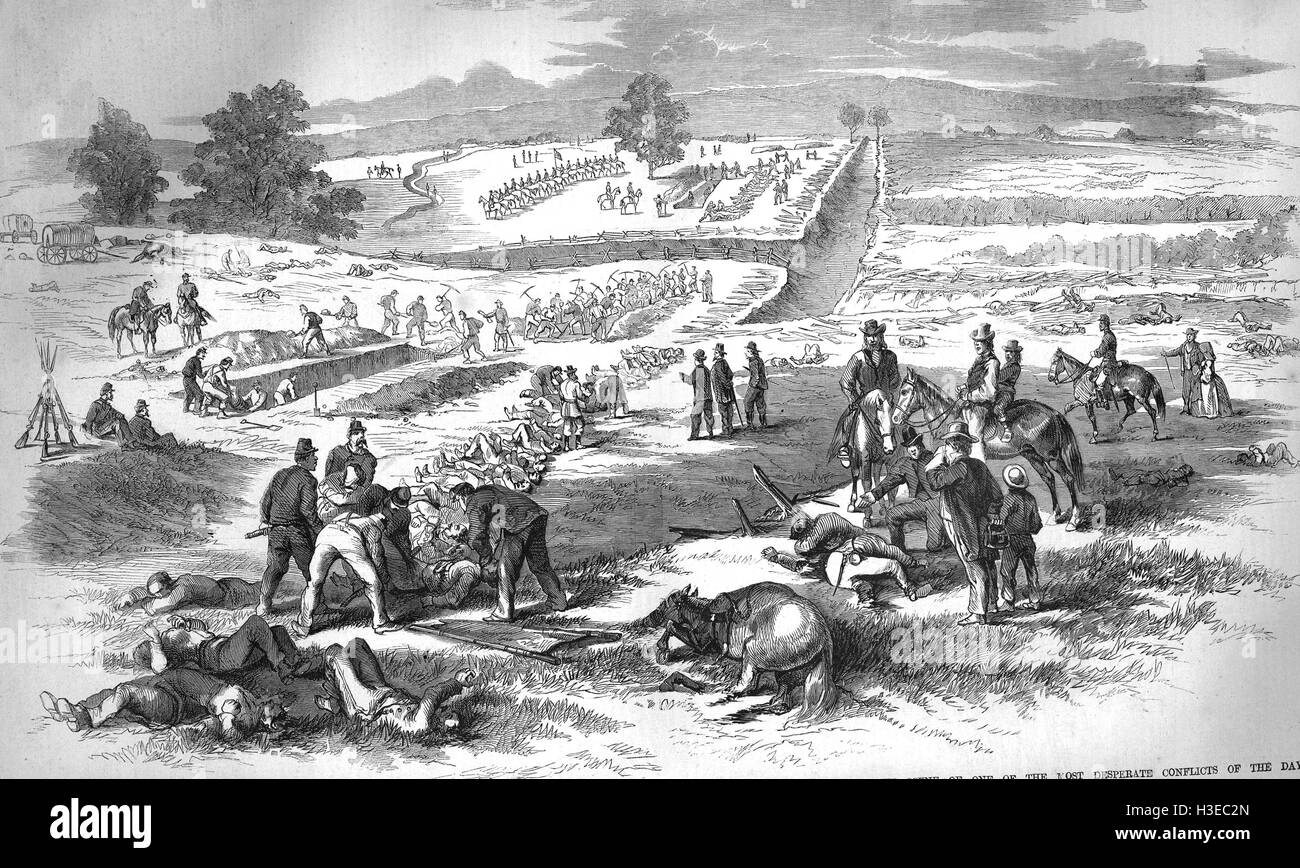The Battle of Antietam stands as one of the most significant events in American history, shaping the course of the Civil War and leaving a lasting impact on the nation's future. Often overshadowed by larger battles, Antietam's importance cannot be overstated. It was not only the bloodiest single-day battle in American history but also a pivotal moment that altered the trajectory of the war.
On September 17, 1862, Union and Confederate forces clashed near Sharpsburg, Maryland, in what would become known as the Battle of Antietam. The conflict, fought along Antietam Creek, resulted in staggering casualties, with over 23,000 soldiers killed, wounded, or missing in just one day. This staggering loss of life highlighted the brutal nature of the Civil War and underscored the urgency of resolving the conflict.
Antietam's significance extends beyond its role as a military engagement. The battle provided President Abraham Lincoln with the opportunity to issue the Emancipation Proclamation, fundamentally altering the war's purpose and redefining the nation's values. Understanding the battle's context, its immediate aftermath, and its long-term implications is crucial for appreciating its historical importance.
Read also:Coolio Height
Table of Contents
- Background of the Battle
- Strategic Importance of Antietam
- Details of the Battle
- The Emancipation Proclamation
- Casualties and Aftermath
- Why Antietam Was a Turning Point
- Impact on the Civil War
- The Modern Legacy of Antietam
- Preservation Efforts
- Conclusion
Background of the Battle
The Battle of Antietam took place during the American Civil War, a period marked by intense division over slavery and states' rights. By 1862, the war had been raging for over a year, with both sides suffering significant losses. Confederate General Robert E. Lee sought to capitalize on recent victories by launching an invasion of the North, hoping to secure foreign recognition and bolster morale among Southern supporters.
Maryland, a border state with divided loyalties, became a critical battleground. Lee's Army of Northern Virginia marched into Maryland, aiming to draw Union forces away from Richmond, the Confederate capital. Meanwhile, Union General George B. McClellan, leading the Army of the Potomac, moved to intercept Lee's forces, setting the stage for the Battle of Antietam.
Key Factors Leading to the Battle
- Lee's strategic decision to invade the North
- The discovery of Special Order 191 by Union forces
- Mcclellan's cautious approach despite having an advantage
Strategic Importance of Antietam
The Battle of Antietam held immense strategic importance for both the Union and Confederate forces. For the Confederacy, a victory on Northern soil could have led to foreign intervention and recognition by European powers, particularly Britain and France. Conversely, a Union victory would weaken Confederate morale and provide President Lincoln with the political leverage needed to issue the Emancipation Proclamation.
Additionally, Maryland's status as a border state made it a crucial target. A Confederate victory there could have swayed undecided Marylanders to support the Southern cause, potentially altering the balance of power in the region.
Details of the Battle
The Battle of Antietam unfolded over a single day, September 17, 1862, and was characterized by intense fighting across three main sectors: the Cornfield, Bloody Lane, and Burnside Bridge. Each sector saw fierce engagements that resulted in heavy casualties on both sides.
The Cornfield
The Cornfield became a symbol of the battle's brutality, with control changing hands multiple times throughout the day. Union forces, under the command of General Joseph Hooker, clashed with Confederate troops led by General Stonewall Jackson. The intense fighting in this area resulted in some of the highest casualties of the entire battle.
Read also:Wedding Mary Ruth Joyner
Bloody Lane
Bloody Lane, a sunken road that provided natural cover for Confederate forces, became another focal point of the battle. Union troops, under the command of General William H. French, launched repeated assaults on the entrenched Confederates. The fighting here was so intense that the road was later renamed Bloody Lane due to the sheer volume of blood spilled.
Burnside Bridge
The struggle for Burnside Bridge was another critical moment in the battle. Union forces, led by General Ambrose Burnside, faced stiff resistance from Confederate troops guarding the bridge. After several failed attempts, the Union eventually secured the bridge, allowing them to advance further into Confederate-held territory.
The Emancipation Proclamation
Perhaps the most significant outcome of the Battle of Antietam was its role in leading to the issuance of the Emancipation Proclamation. Following the Union's strategic victory, President Lincoln announced the proclamation on September 22, 1862, declaring that all enslaved people in Confederate-held territory would be freed as of January 1, 1863. This executive order transformed the war's purpose, shifting it from a struggle to preserve the Union to a fight for human freedom.
The Emancipation Proclamation also had international implications, discouraging European powers from recognizing or supporting the Confederacy. By linking the war effort to the abolition of slavery, Lincoln ensured that the conflict would have a moral dimension that resonated globally.
Casualties and Aftermath
The Battle of Antietam resulted in staggering casualties, with over 23,000 soldiers killed, wounded, or missing in just one day. This made it the bloodiest single-day battle in American history. The sheer scale of the losses highlighted the brutal reality of the Civil War and underscored the need for a decisive resolution to the conflict.
In the aftermath of the battle, both sides regrouped and reassessed their strategies. For the Union, the victory provided much-needed momentum, while the Confederacy was forced to retreat back into Virginia. The battle also prompted renewed calls for better medical care for wounded soldiers, leading to improvements in battlefield medicine and the establishment of more effective field hospitals.
Why Antietam Was a Turning Point
The Battle of Antietam is often regarded as a turning point in the Civil War for several reasons:
- Moral Shift: The issuance of the Emancipation Proclamation fundamentally altered the war's purpose, transforming it into a fight for freedom.
- Strategic Victory: Although not a decisive defeat for the Confederacy, Antietam halted Lee's invasion of the North and forced him to retreat.
- International Impact: The Union victory discouraged foreign intervention, particularly from Britain and France, which had been considering recognizing the Confederacy.
Impact on the Civil War
The Battle of Antietam had a profound impact on the course of the Civil War. It marked the beginning of a shift in Union strategy, with increased emphasis on targeting the Confederacy's economic and social infrastructure. The Emancipation Proclamation also opened the door for African American soldiers to join the Union Army, significantly bolstering its ranks.
Moreover, the battle highlighted the importance of leadership and decision-making in warfare. While General McClellan's cautious approach has been criticized, his ability to halt Lee's advance demonstrated the Union's growing capability to withstand Confederate offensives.
The Modern Legacy of Antietam
Today, the Battle of Antietam is remembered not only for its historical significance but also for its enduring legacy. The Antietam National Battlefield, established in 1890, serves as a national park and memorial to those who fought and died there. The site attracts thousands of visitors each year, offering educational programs and guided tours that help preserve the memory of this pivotal moment in American history.
In addition to its historical value, Antietam continues to inspire discussions about the enduring struggle for civil rights and equality in the United States. The battle's connection to the Emancipation Proclamation makes it a powerful symbol of the nation's progress toward justice and freedom.
Preservation Efforts
Efforts to preserve the Antietam battlefield have been ongoing since the late 19th century. The establishment of the Antietam National Battlefield by Congress in 1890 marked the beginning of formal preservation efforts. Today, the National Park Service manages the site, ensuring that its historical significance is maintained for future generations.
Private organizations, such as the American Battlefield Trust, also play a crucial role in preserving the battlefield and educating the public about its importance. Through fundraising and advocacy, these groups help protect the land and promote awareness of Antietam's role in American history.
Conclusion
The Battle of Antietam remains one of the most significant events in American history, shaping the course of the Civil War and leaving a lasting impact on the nation. From its role in leading to the issuance of the Emancipation Proclamation to its influence on international relations, Antietam's significance cannot be overstated.
As we reflect on this pivotal moment in history, it is essential to recognize the sacrifices made by those who fought and died at Antietam. By preserving the battlefield and continuing to educate others about its importance, we honor their legacy and ensure that the lessons of the past are not forgotten.
We invite you to explore more about Antietam and its impact on American history by visiting the Antietam National Battlefield or reading additional articles on our site. Share your thoughts in the comments below or spread the word by sharing this article with others. Together, we can keep the memory of Antietam alive for generations to come.


